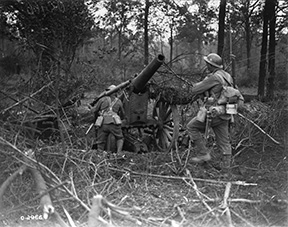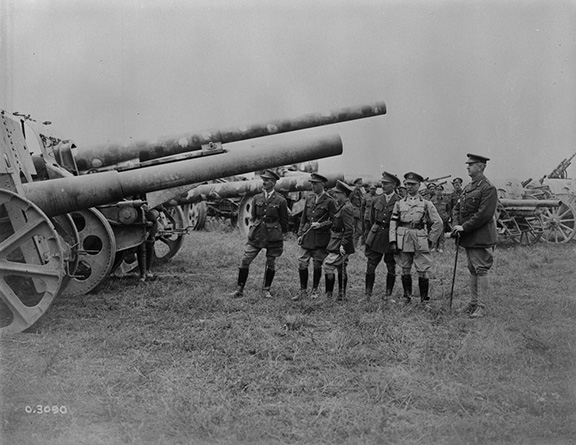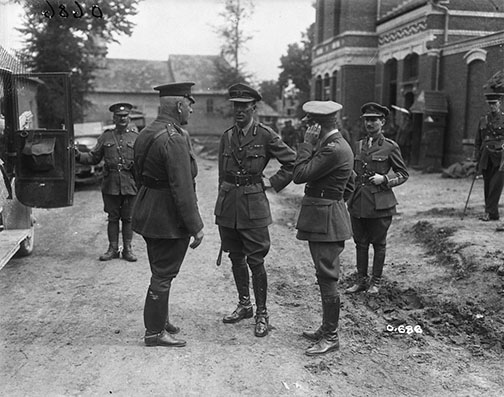Amiens

Machine gunners advancing into a wood passing German gun. Battle of Amiens, August, 1918.
Credit: Canada. Department of National Defence/Library and Archives Canada; (MIKAN no. 3397890)
The First World War
Date
8-11 August 1918
Geographical parameters
Between the roads Amiens — Royes and Amiens — Albert (Amiens exclusive)
Context
A group honour formally entitled The Battle of Amiens and itself being part of The Advance in Picardy (8 August — 3 September 1918).Footnote 1
Description
The Honour “Amiens” was awarded for the Allied offensive in the Picardy region of France to retake the ground gained by the German Army during the 1918 Spring Offensive. The British divisions in the area had been weakened by the many months of difficult fighting to halt the advance. The Canadian Corps (Lieutenant-General Sir A.W. Currie) had not suffered greatly from the German attacks and was selected along with the Australian Corps to form the British portion of an Anglo-French attack against the apex of the German salient east of Amiens. General Currie was made aware of the plan for his Corps as early as 20 July but planning for the attack was to be done under utmost secrecy. Canadian troops did not start moving to the area until after 1 August and only moved at night. To deceive the Germans, Canadian preparations for an attack in the Arras area continued and a few Canadian units and signalers were moved to the Flanders area to give the impression of a Canadian build up in that area. Division commanders were not told of the attack until the 30th of July and Canadian soldiers who began the move thought they were going to the Ypres front until they loaded onto vehicles in the rear areas and received orders to move toward Amiens. The logistical undertaking was enormous but in a short period most of the Canadian Corps' soldiers, equipment, guns and huge stocks of ammunition were in place for the attack. The left-hand Canadian Corps boundary, with the Australians, was along the railway line between Amiens and Chaulnes. On the Canadian right was the French 31st Corps to the south of the Amiens Roye road.
The Battle opened on the 8th of August under a heavy artillery barrage. To maintain surprise there had been no preparatory artillery fire. The Canadian Corps had the 1st, 2nd and 3rd Divisions in the front line with each division having only a one-brigade frontage. The purpose of the attack was to advance deeply into the German defences. The brigades of the first wave gained their objectives within a short time allowing the brigades of the second wave to leap frog and continue to push the Germans back. The Canadian Cavalry Brigade (Brigadier-General J.E.B. Seely), as part of the 3rd Cavalry Division, also took part. This Division was tasked with continuing the attack on the Corps' right beyond the advance of the 3rd Division. On this first day the Canadian Corps took all its objectives and seized the German 'Outer Amiens Defence Line' advancing over 12 kilometres at its deepest point. Only the village of the Le Quesnel, an objective of the Cavalry Division, was still in German hands. The Germans brought up several divisions as reinforcements during the night of 8 — 9 August. Canadian plans for the next phase initially included a British Division that was removed from Canadian control at the last minute. This caused a great deal of confusion in orders and delayed operations on the 9th of August. Units of all four Canadian Divisions participated that day and in spite of the delays and increased German reinforcements, the depth of the advance increased by over 6 kilometres. The Canadian Corps continued to press the Germans the next morning, having reached the 1916 trench lines. The wire, obstacles and trenches of these former defensive positions proved difficult to move through in some areas. However, over the next few days in a series of small operations the Germans were pushed back beyond their old defensive positions. The last Canadian units in the area were relieved on 20 August after having advanced over 20 kilometres, capturing more than 9000 prisoners, 200 guns, over a thousand machine guns and trench mortars. The Canadians and their allies had taken back almost all the ground lost in Picardy during the German spring offensive but more importantly, with this attack, they had gained the initiative.

Canadian Corps Commander, Lieutenant General Sir Arthur Currie is examining two types of 15cm German naval cannon on field carriages. Battle of Amiens. August, 1918.
Credit: Canada. Department of National Defence/Library and Archives
Canada (MIKAN no. 3397915)

General Sir Sam Huges (left fore) visiting the Front, talking with Brigadier-Gereral Seely (middle fore). August, 1916. Location unknown.
Credit: Canada. Department of National Defence/PA-000599 Library and Archives Canada/PA-000599; (MIKAN no. 3221015)
Awarded to:
Currently serving units
- 1st Hussars
Award to the 1st Hussars (GO 71/30) - 10th Field Artillery Regiment, RCA
Award to The Assiniboia Regiment (GO 71/30) - 12e Régiment blindé du Canada
Award to The Three Rivers Regiment (GO 71/30) - 26th Field Artillery Regiment, RCA
Award to The Manitoba Rangers (GO 71/30) - 31 Combat Engineer Regiment (The Elgin's)
Award to The Elgin Regiment (GO 71/30) - 42nd Field Artillery Regiment (Lanark and Renfrew Scottish), RCA
Award to The Lanark and Renfrew Scottish Regiment (GO 71/30) - 48th Highlanders of Canada
Awards to the 15th Canadian Infantry Battalion, CEF (GO 110/29) and The 48th Regiment (Highlanders) (GO 110/29) - 49th Field Artillery Regiment, RCA
Award to The Sault Ste. Marie Regiment (GO 71/30) - 56th Field Artillery Regiment, RCA
Awards to the 4th Canadian Infantry Battalion, CEF (GO 110/29) and The Dufferin Rifles of Canada (GO 110/29) - 64th Field Battery, RCA
Award to The Yorkton Regiment (GO 71/30) - 116th Independent Field Battery, RCA
Award to The Kenora Light Infantry (GO 71/30) - The Argyll and Sutherland Highlanders of Canada (Princess Louise's)
Awards to the 19th Canadian Infantry Battalion, CEF (GO 110/29), the 3rd Battalion, Canadian Machine Gun Corps, CEF (GO 123/29), The Argyll and Sutherland Highlanders of Canada (Princess Louise's) (GO 110/29), and the 3rd Machine Gun Battalion, CMGC (GO 123/29) - The Black Watch (Royal Highland Regiment) of Canada
Awards to the 13th Canadian Infantry Battalion, CEF (GO 110/29), the 42nd Canadian Infantry Battalion, CEF (GO 110/29), and The Royal Highlanders of Canada (GO 110/29) - The British Columbia Dragoons
Awards to the 2nd Canadian Mounted Rifles Battalion, CEF (GO 110/29) and The British Columbia Dragoons (GO 110/29) - The British Columbia Regiment (Duke of Connaught's Own)
Awards to the 7th Canadian Infantry Battalion, CEF (GO 71/30), the 29th Canadian Infantry Battalion, CEF (GO 123/29), the 102nd Canadian Infantry Battalion, CEF (GO 110/29), the 1st British Columbia Regiment (Duke of Connaught's Own) (GO 110/29), The North British Columbia Regiment (GO 123/29), The Irish Fusiliers of Canada (GO 71/30), and The Vancouver Regiment (GO 71/30) - The Brockville Rifles
Award to The Brockville Rifles (GO 71/30) - The Calgary Highlanders
Awards to the 10th Canadian Infantry Battalion, CEF (GO 123/29) and The Calgary Highlanders (GO 110/29) - The Cameron Highlanders of Ottawa
Awards to the 38th Canadian Infantry Battalion, CEF (GO 123/29) and The Ottawa Highlanders (GO 110/29) - The Canadian Grenadier Guards
Awards to the 87th Canadian Infantry Battalion, CEF (GO 110/29) and The Canadian Grenadier Guards (GO 110/29) - The Canadian Scottish Regiment (Princess Mary's)
Awards to the 16th Canadian Infantry Battalion, CEF (GO 110/29) and The Canadian Scottish Regiment (GO 110/29) - The Cape Breton Highlanders
Awards to the 85th Canadian Infantry Battalion, CEF (GO 110/29) and The Cape Breton Highlanders (GO 110/29) - The Essex and Kent Scottish
Awards to the 18th Canadian Infantry Battalion, CEF (GO 110/29) and The Essex Scottish (GO 110/29) - The Fort Garry Horse
Awards to The Fort Garry Horse (GO 5/31) and The Manitoba Horse (GO 88/31) - Les Fusiliers de Sherbrooke
Award to Les Carabiniers de Sherbrooke (GO 71/30)
Les Fusiliers Mont-Royal
Award to Les Carabiniers Mont-Royal (GO 71/30) - Governor General's Foot Guards
Awards to the 2nd Canadian Infantry Battalion, CEF (GO 123/29) and The Governor General's Foot Guards (GO 71/30 and GO 32/32) - The Governor General's Horse Guards
Awards to the 4th Canadian Mounted Rifles Battalion, CEF (GO 110/29), The Governor General's Body Guard (GO 112/35) and The Mississauga Horse (GO 110/29) - The Grey and Simcoe Foresters
Awards to The Grey Regiment (GO 71/30) and The Simcoe Foresters (GO 71/30) - The Halifax Rifles (RCAC)
Award to The Halifax Rifles (GO 71/30) - The Hastings and Prince Edward Regiment
Awards to The Hastings and Prince Edward Regiment (GO 71/30), The Argyll Light Infantry (GO 71/30), and The Northumberland Regiment (GO 71/30) - Irish Regiment of Canada
Awards to the 1st Battalion, Canadian Machine Gun Corps, CEF (GO 123/29), the 1st Machine Gun Battalion, CMGC (GO 123/29) and The Irish Regiment (GO 71/30) - The King's Own Calgary Regiment (RCAC)
Awards to the 50th Canadian Infantry Battalion, CEF (GO 110/29) and The Calgary Regiment (GO 110/29) - The Lake Superior Scottish Regiment
Awards to the 52nd Canadian Infantry Battalion, CEF (GO 123/29) and The Lake Superior Regiment (GO 110/29) - The Lincoln and Welland Regiment
Award to The Lincoln Regiment (GO 71/30) - Lord Strathcona's Horse (Royal Canadians)
Award to Lord Strathcona's Horse (Royal Canadians) (GO 5/31) - The Lorne Scots (Peel, Dufferin and Halton Regiment)
Awards to The Halton Rifles (GO 71/30) and The Peel and Dufferin Regiment (GO 71/30) - The Loyal Edmonton Regiment (4th Battalion, Princess Patricia's Canadian Light Infantry)
Awards to the 49th Canadian Infantry Battalion, CEF (GO 110/29) and The Edmonton Regiment (GO 110/29) - The North Saskatchewan Regiment
Awards to the 1st Canadian Mounted Rifles Battalion, CEF (GO 110/29), the 5th Canadian Infantry Battalion, CEF (GO 110/29), the 16th Canadian Light Horse (GO 110/29), The Saskatchewan Mounted Rifles (GO 110/29), The Saskatoon Light Infantry (GO 110/29), The Battleford Light Infantry (GO 71/30), and The Prince Albert Volunteers (GO 71/30) - The North Shore (New Brunswick) Regiment
Award to The North Shore (New Brunswick) Regiment (GO 71/30) - The Nova Scotia Highlanders
Awards to the 25th Canadian Infantry Battalion, CEF (GO 123/29), The Colchester and Hants Regiment (GO 110/29), The Pictou Highlanders (GO 71/30), and The Cumberland Highlanders (GO 71/30) - The Ontario Regiment (RCAC)
Awards to the 116th Canadian Infantry Battalion, CEF (GO 110/29) and The Ontario Regiment (GO 123/29) - The Prince Edward Island Regiment (RCAC)
Awards to The Prince Edward Island Light Horse (GO 71/30) and The Prince Edward Island Highlanders (GO 71/30) - The Princess Louise Fusiliers
Award to The Princess Louise Fusiliers (GO 71/30) - The Princess of Wales' Own Regiment
Awards to the 21st Canadian Infantry Battalion, CEF (GO 123/29) and The Princess of Wales' Own Regiment (GO 110/29) - Princess Patricia's Canadian Light Infantry
Award to Princess Patricia's Canadian Light Infantry (GO 123/29) - The Queen's Own Cameron Highlanders of Canada
Awards to the 43rd Canadian Infantry Battalion, CEF (GO 110/29) and The Queen's Own Cameron Highlanders of Canada (GO 110/29) - The Queen's Own Rifles of Canada
Awards to the 3rd Canadian Infantry Battalion, CEF (GO 123/29) and The Queen's Own Rifles of Canada (GO 110/29) - The Queen's York Rangers (1st American Regiment) (RCAC)
Awards to the 20th Canadian Infantry Battalion, CEF (GO 110/29), The Queen's Rangers, 1st American Regiment (GO 110/29), and The York Rangers (GO 71/30) - Le Régiment de Maisonneuve
Awarded through perpetuation of the 41st Canadian Infantry Battalion, CEF (CAO Part “A“ 33-1 and 229-1 10 July 1961) - The Rocky Mountain Rangers
Award to The Rocky Mountain Rangers (GO 71/30) - Royal 22e Régiment
Award to the Royal 22e Régiment (GO 110/29) - The Royal Canadian Dragoons
Award to The Royal Canadian Dragoons (GO 5/31). - The Royal Canadian Hussars (Montreal)
Awards to the 1st Canadian Motor Machine Gun Brigade, CEF (GO 110/29) and the 1st Motor Machine Gun Brigade (GO 110/29) - The Royal Canadian Regiment
Awards to the 1st Canadian Infantry Battalion, CEF (GO 110/29), the 2nd Battalion, Canadian Machine Gun Corps, CEF (GO 123/29), The Royal Canadian Regiment (GO 110/29), The Canadian Fusiliers (City of London Regiment) (GO 110/29), the 2nd Machine Gun Battalion, CMGC (GO 123/29), and The Oxford Rifles (GO 71/30) - The Royal Hamilton Light Infantry (Wentworth Regiment)
Awards to the 4th Canadian Infantry Battalion, CEF (GO 110/29) and The Royal Hamilton Light Infantry (GO 110/29) - The Royal Highland Fusiliers of Canada
Award to The Highland Light Infantry of Canada (GO 71/30) - The Royal Montreal Regiment
Awards to the 14th Canadian Infantry Battalion, CEF (GO 110/29) and The Royal Montreal Regiment (GO 110/29) - The Royal New Brunswick Regiment
Awards to the 26th Canadian Infantry Battalion, CEF (GO 110/29), The Carleton Light Infantry (GO 110/29), The Saint John Fusiliers (GO 110/29), The York Regiment (GO 71/30), and The New Brunswick Rangers (GO 71/30) - The Royal Regiment of Canada
Awards to the 3rd Canadian Infantry Battalion, CEF (GO 123/29), the 58th Canadian Infantry Battalion, CEF (GO 110/29), The Royal Grenadiers (GO 110/29), and The Toronto Regiment (GO 110/29) - The Royal Regina Rifles
Awards to the 28th Canadian Infantry Battalion, CEF (GO 110/29) and The Regina Rifle Regiment (GO 110/29) - The Royal Westminster Regiment
Awards to the 47th Canadian Infantry Battalion, CEF (GO 110/29) and The Westminster Regiment (GO 110/29) - The Royal Winnipeg Rifles
Awards to the 8th Canadian Infantry Battalion, CEF (GO 110/29), the 10th Canadian Infantry Battalion, CEF (GO 123/29), the 27th Canadian Infantry Battalion, CEF (GO 123/29), the 44th Canadian Infantry Battalion, CEF (GO 110/29), The Winnipeg Rifles (GO 110/29), and The Winnipeg Light Infantry (GO 110/29) - The Saskatchewan Dragoons
Awards to the 46th Canadian Infantry Battalion, CEF (GO 110/29) and The King's Own Rifles of Canada (GO 110/29) - The Seaforth Highlanders of Canada
Awards to the 72nd Canadian Infantry Battalion, CEF (GO 5/31) and The Seaforth Highlanders of Canada (GO 5/31) - The Sherbrooke Hussars
Awards to the 5th Canadian Mounted Rifles Battalion, CEF (GO 110/29), The Sherbrooke Regiment (GO 71/30), and the 7th/11th Hussars (GO 10/39) - The South Alberta Light Horse
Awards to the 31st Canadian Infantry Battalion, CEF (GO 110/29), The South Alberta Regiment (GO 110/29), the 19th Alberta Dragoons (GO 71/30), The Edmonton Fusiliers (GO 71/30), and The South Alberta Horse (GO 88/31) - Stormont, Dundas and Glengarry Highlanders
Award to The Stormont, Dundas and Glengarry Highlanders (GO 71/30) - The Toronto Scottish Regiment (Queen Elizabeth The Queen Mother's Own)
Awards to the 75th Canadian Infantry Battalion, CEF (GO 110/29) and The Toronto Scottish Regiment (GO 110/29) - Les Voltigeurs de Québec
Award to Les Voltigeurs de Québec (GO 71/30) - The West Nova Scotia Regiment
Awards to The Annapolis Regiment (GO 71/30) and The Lunenburg Regiment (GO 71/30)
Units on the Supplementary Order of Battle
- 11th Field Squadron, RCE
Award to The Lambton Regiment (GO 71/30) - 12th Manitoba Dragoons
Award to The Border Horse (GO 59/32) - 14th Canadian Hussars
Award to the 14th Canadian Light Horse (GO 5/31) - 21st Field Artillery Regiment, RCA
Award to The Wellington Rifles (GO 71/30) - 24th Field Artillery Regiment, RCA
Awards to the 54th Canadian Infantry Battalion, CEF (GO 110/29) and The Kootenay Regiment (GO 110/29) - 26th Field Battery, RCA
Awards to The Lambton Regiment (GO 71/30) and The Wellington Rifles (GO 71/30) - 27th Field Artillery Regiment, RCA
Award to The Eastern Townships Mounted Rifles (GO 110/29) - 38th Field Battery, RCA
Awards to the 2nd Canadian Motor Machine Gun Brigade, CEF (GO 71/30), the Machine Gun Squadron, Canadian Cavalry Brigade, CEF (GO 5/31), the 1st Cavalry Machine Gun Squadron (GO 5/31), and the 2nd Motor Machine Gun Brigade, CMGC (GO 71/30) - 48th Field Squadron, RCE
Award to The Lambton Regiment (GO 71/30) - 50th Field Artillery Regiment (The Prince of Wales' Rangers), RCA
Awards to the 2nd Canadian Infantry Battalion, CEF (GO 123/29), the 4th Battalion, Canadian Machine Gun Corps, CEF (GO 123/29), The Peterborough Rangers (GO 110/29), and the 4th Machine Gun Battalion, CMGC (GO 123/29). - 65th Field Battery, RCA
Award to The Assiniboia Regiment (GO 71/30) - 76th Field Battery, RCA
Award to The Assiniboia Regiment (GO 71/30) - 97th Field Battery, RCA
Award to The Bruce Regiment (GO 71/30) - 98th (Huron) Field Battery, RCA
Award to The Bruce Regiment (GO 71/30) - 99th Field Battery, RCA
Award to The Wellington Rifles (GO 71/30) - 101st Field Battery (Self-Propelled), RCA
Award to The Assiniboia Regiment (GO 71/30) - 118th Medium Battery, RCA
Awards to the 1st Canadian Mounted Rifles Battalion, CEF (GO 110/29) and The Manitoba Mounted Rifles (GO 5/31) - 202nd Field Battery, RCA
Award to The Yorkton Regiment (GO 71/30) - The Royal Rifles of Canada
Award to The Royal Rifles of Canada (GO 71/30) - Victoria Rifles of Canada
Awards to the 24th Canadian Infantry Battalion, CEF (GO 110/29) and The Victoria Rifles of Canada (GO 110/29) - The Winnipeg Grenadiers
Awards to the 78th Canadian Infantry Battalion, CEF (GO 110/29) and The Winnipeg Grenadiers (GO 110/29)
Disbanded Units
- 16th/17th (Reserve) Medium Battery, RCA
Award to The Kenora Light Infantry (GO 71/30) - The Irish Canadian Rangers
Award to The Irish Canadian Rangers (GO 71/30) - The Manitoba Regiment
Award to The Manitoba Regiment (GO 123/29) - McGill University Contingent (148th Bn., C.E.F.), The Canadian Officers' Training Corps
Award to the McGill University Contingent (148th Bn., C.E.F.), The Canadian Officers' Training Corps (GO 136/32) - The Middlesex and Huron Regiment
Awards to The Middlesex Light Infantry (GO 71/30) and The Huron Regiment (GO 71/30) - The North Alberta Regiment
Awards to the 31st Canadian Infantry Battalion, CEF (GO 110/29) and The North Alberta Regiment (GO 110/29)